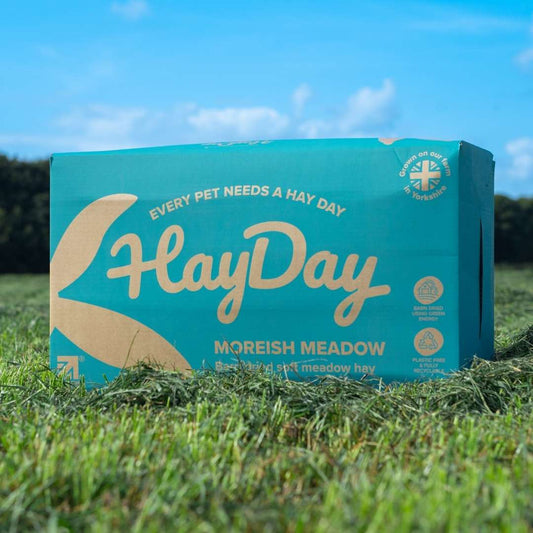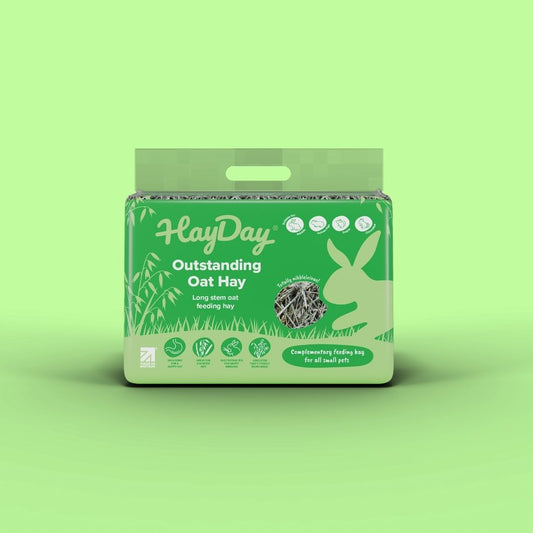Guinea pigs are wonderful pets that rely on a balanced diet to stay healthy and happy.
If you’ve ever wondered whether bananas are safe for your furry friends, this guide from the experts at HayDay will answer that and guide you through the essential elements of guinea pig nutrition, including the important role hay plays in their diet.
Shop Now > Premium, long stem hay for guinea pigs.
Can Guinea Pigs Eat Bananas?
The short answer is yes - guinea pigs can eat bananas but only as an occasional treat. Bananas are packed with natural sugars and fibre, so feeding too much can upset their delicate digestive system.
While bananas contain valuable nutrients like vitamin C (which guinea pigs can’t produce on their own) and potassium (great for heart and muscle function), it’s crucial to limit banana treats to a small slice once or twice a week.
Bananas should never replace your guinea pig’s regular meals (such as hay), but can be a delightful reward now and then. Feeding excessive bananas could lead to problems such as diarrhoea, bloating, and even obesity, so moderation is key.
Bananas and Other Safe Foods for Guinea Pigs
Beyond special treats like bananas, a healthy guinea pig diet includes a constant supply of hay, pellets rich in vitamin C plus a variety of fresh vegetables and leafy greens that provide vital nutrients.
Leafy greens such as romaine lettuce, kale, parsley, and cilantro are excellent staples that offer both vitamin C and fibre.
Bell peppers are especially good because they provide a high amount of vitamin C with low calcium, which is important for maintaining the right mineral balance in your guinea pig’s body.
Other fruits like strawberries, apples (without seeds), blueberries, melon, and pears can also be fed sparingly, adding variety and interest to mealtime - which ultimately diversifies their diet.
It’s important to introduce new foods gradually (over a period of 7 to 14 days) so their sensitive digestive systems can adjust and allow time to watch for any adverse reactions.
The Critical Role of Hay in Guinea Pig Nutrition
Hay is truly the foundation of a guinea pig’s diet and should make up the majority - about 80 to 90 percent - of everything they eat.
Good-quality guinea pig hay, like timothy hay or meadow hay, provides the high levels of fibre guinea pigs need to maintain a healthy digestive tract. Feeding a range of different hay types will help add diversity to your guinea pigs diet - other suitable forage options include:
Since their teeth grow continuously, the chewing action from fibrous hay also naturally wears down their teeth, preventing painful overgrowth and dental problems.
Without constant access to fresh hay, guinea pigs are at risk of developing gut stasis - a serious condition where the digestive system slows or stops - and dental issues and diseases.
Balancing Pellets and Fresh Foods
Pellets specially formulated for guinea pigs can play an important role in ensuring they get all the vitamins and minerals they need, particularly vitamin C, which is crucial for preventing scurvy.
However, pellets should be given in limited amounts, roughly one tablespoon per day, as too many can contribute to excess weight gain.
Fresh vegetables and fruit add diversity to their diet and provide extra hydration, but should complement (not replace) hay and pellets. Offering a daily mix of vegetables rich in vitamin C, along with leafy greens, will promote a happy, healthy guinea pig.
Introducing New Foods Safely
When adding bananas or any new food to your guinea pig’s diet, do so slowly and in small amounts.
This cautious approach helps prevent digestive upsets and allows you to observe how your pet reacts. Avoid feeding toxic foods such as chocolate, onions, potatoes, or anything with seeds and pits.
If your guinea pig shows signs of discomfort, such as diarrhoea, lethargy, or skin irritation after eating something new, stop feeding any new foods immediately and consult an experienced exotic vet.
Feeding Your Guinea Pig for a Long, Healthy Life
Feeding your guinea pig well protects their health and supports a joyful, active life.
Their diet should prioritise unlimited guinea pig hay as a constant food source, supplemented with fresh vegetables, approximately an egg-cup full of vitamin C rich pellets and the occasional banana or other fruit treat.
The balance of nutrients will keep their teeth healthy, digestion smooth and immune system strong.
Remember, while bananas can be a tasty treat, moderation is essential. By offering a well-rounded diet designed around their natural needs, your guinea pig can thrive for many happy years by your side.
FAQS
How much banana can I safely give my guinea pig at one time?
It’s best to offer a small slice of banana per week as a treat. Overfeeding bananas, and other fruits, can cause digestive upset due to their high sugar content.
Can guinea pigs eat banana peel?
Yes, but only in very small amounts and only if it’s organic and thoroughly washed to avoid pesticide residue. Banana peels have fibre, but also are harder to digest.
How often should I change my guinea pig’s hay?
Hay should be refreshed daily or whenever it becomes soiled to keep it fresh and palatable. Consistent access to fresh hay is vital for dental and digestive health.
Can guinea pigs eat other tropical fruits besides bananas?
Many tropical fruits like mango, papaya, and pineapple can be offered in tiny quantities occasionally, but always watch for sugary content and introduce new fruits cautiously.
What are signs my guinea pig is eating too much sugar?
Look out for diarrhoea, bloating, weight gain, or changes in appetite and energy. Guinea pigs are prone to obesity and digestive problems from excess sugary foods.
Useful Links
Best Types of Hay for Small Pets - HayDay
Essential Enrichment for Guinea Pigs - HayDay





